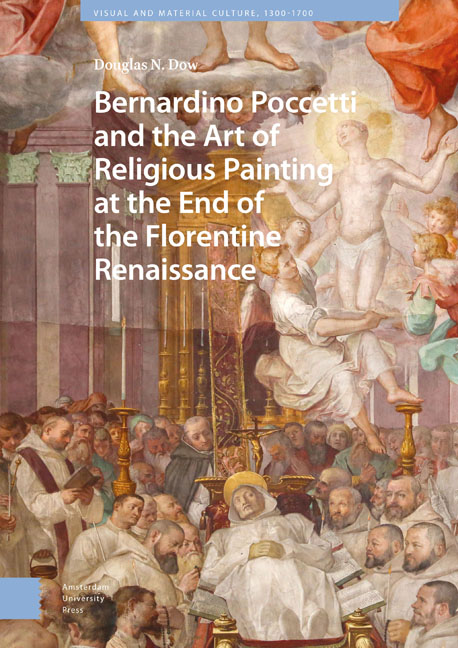Book contents
- Frontmatter
- Contents
- List of Illustrations
- List of Abbreviations
- Acknowledgments
- Introduction: ‘Il primo huomo da dipingere in fresco, che sia in questi paesi’: Bernardino Poccetti and the Historiography of Florentine Painting during the Late Renaissance
- 1 ‘Grandemente inclinato all’Arte del Disegno’: Filippo Baldinucci’s Biography of Bernardino Poccetti
- 2 ‘Le prime cose lodevoli molto’: Bernardino Poccetti’s Early Work and the Frescoes from the Life of Saint Dominic in the Chiostro Grande, Santa Maria Novella
- 3 ‘Locum ecclesiae designavit, quae Ioannis et uxoris pecunia extructa est’: Bernardino Poccetti and the Decoration of the Canigiani Chapel in Santa Felicita
- 4 ‘Miracula et alia id genus’: Bernardino Poccetti’s Frescoes in the Church of San Lorenzo at the Certosa del Galluzzo
- Color Plates
- 5 ‘L’inventore di dipingere tutte le muraglie della nostra chiesa’: Bernardino Poccetti and the Sixteenth-Century Decoration of Santa Maria del Carmine
- Conclusion
- Bibliography
- Index
3 - ‘Locum ecclesiae designavit, quae Ioannis et uxoris pecunia extructa est’: Bernardino Poccetti and the Decoration of the Canigiani Chapel in Santa Felicita
Published online by Cambridge University Press: 13 February 2024
- Frontmatter
- Contents
- List of Illustrations
- List of Abbreviations
- Acknowledgments
- Introduction: ‘Il primo huomo da dipingere in fresco, che sia in questi paesi’: Bernardino Poccetti and the Historiography of Florentine Painting during the Late Renaissance
- 1 ‘Grandemente inclinato all’Arte del Disegno’: Filippo Baldinucci’s Biography of Bernardino Poccetti
- 2 ‘Le prime cose lodevoli molto’: Bernardino Poccetti’s Early Work and the Frescoes from the Life of Saint Dominic in the Chiostro Grande, Santa Maria Novella
- 3 ‘Locum ecclesiae designavit, quae Ioannis et uxoris pecunia extructa est’: Bernardino Poccetti and the Decoration of the Canigiani Chapel in Santa Felicita
- 4 ‘Miracula et alia id genus’: Bernardino Poccetti’s Frescoes in the Church of San Lorenzo at the Certosa del Galluzzo
- Color Plates
- 5 ‘L’inventore di dipingere tutte le muraglie della nostra chiesa’: Bernardino Poccetti and the Sixteenth-Century Decoration of Santa Maria del Carmine
- Conclusion
- Bibliography
- Index
Summary
Abstract: Bernardino Barbatelli (called Poccetti, 1553–1612) painted much of the imagery in the Canigiani Chapel at Santa Felicita. Commissioned by Giovanni Canigiani at the end of the sixteenth century, the decorative program—which includes a mural of the miraculous snowfall that led to the foundation of Santa Maria Maggiore in Rome—reveals how Canigiani and Poccetti collaborated to create a complex iconography that reflected contemporary Catholic concerns regarding art patronage, the importance of saintly intercessors, and the role of bishops in implementing the reforms of the Council of Trent. Although overshadowed by Pontormo's efforts in the facing Capponi Chapel, the images in the Canigiani Chapel are a striking example of Florentine religious painting in the period of church reform.
Keywords: Bernardino Barbatelli (called Poccetti); Canigiani; Santa Felicita, Florence; Santa Maria Maggiore, Rome; Virgin Mary
In the late 1580s, when Giovanni Canigiani turned his attention to the renovation of the chapel that is immediately on the left as one enters the church of Santa Felicita, his family had enjoyed patronage rights to the space for over two centuries (Fig. 3.1). A document drawn up on 17 March 1366 granted Taddeo di Vanni Canigiani the right to establish, endow, and furnish a chapel dedicated to Maria Assunta in this location, with the stipulations that the construction of the chapel be completed within three years of the contract and that the furnishing of it be finished before the end of Taddeo's life. The sixteenth-century renovation of the chapel was precipitated by Grand Duke Ferdinando I's plan to build a viewing room (coretto) above the Canigiani Chapel that would mirror the coretto above the Capponi Chapel on the other side of the church's entrance. Situated above the Canigiani Chapel, such a vantage point provided an unimpeded and elevated view of the nave and high altar of Santa Felicita. Additionally, this viewing room was located along the route of the Vasari Corridor, the private passageway that Giorgio Vasari had affixed to the facade of Santa Felicita in 1565 as it made its way from the Palazzo Pitti to the Uffizi, and which provided the Medici with discreet access to the coretto.
- Type
- Chapter
- Information
- Bernardino Poccetti and the Art of Religious Painting at the End of the Florentine Renaissance , pp. 131 - 168Publisher: Amsterdam University PressPrint publication year: 2023

